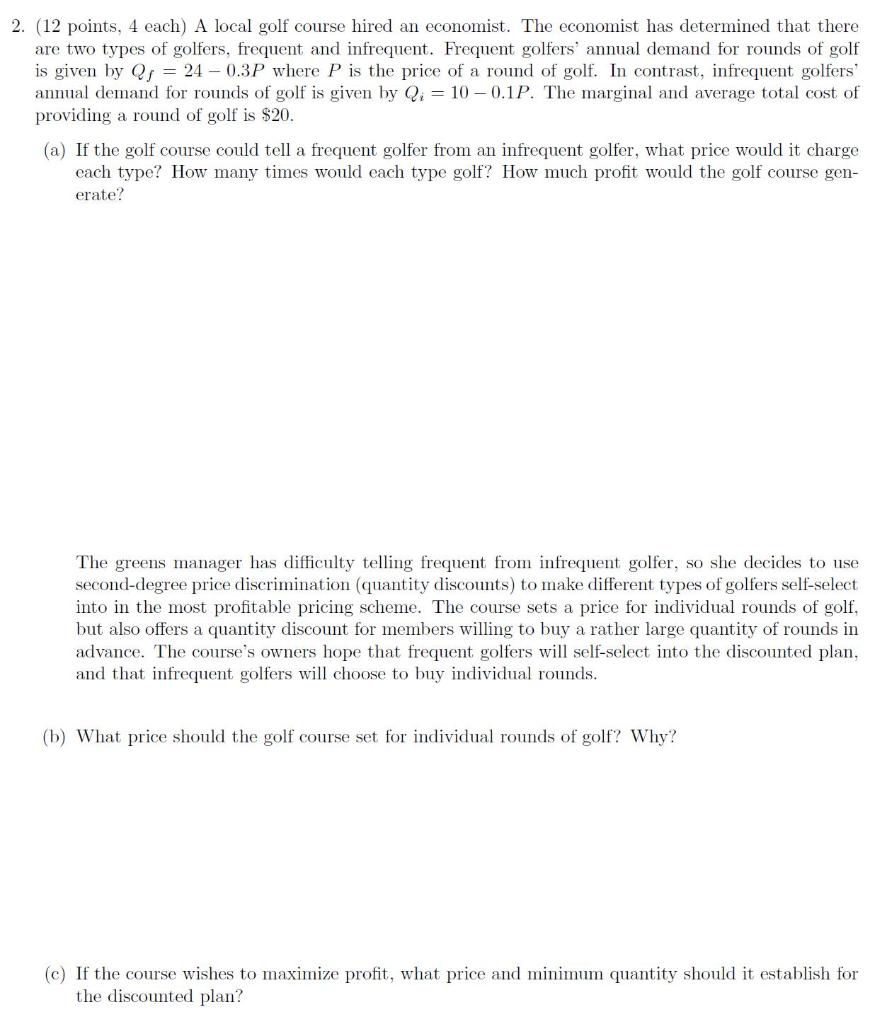
2. (12 points, 4 each) A local golf course hired an economist. The economist has determined that there are two types of golfers, frequent and infrequent. Frequent golfers' annual demand for rounds of golf is given by Q, = 24 -0.3P where P is the price of a round of golf. In contrast, infrequent golfers' annual demand for rounds of golf is given by Qi = 10 -0.1P. The marginal and average total cost of providing a round of golf is $20. (a) If the golf course could tell a frequent golfer from an infrequent golfer, what price would it charge cach type? How many times would each type golf? How much profit would the golf course gen- erate? The greens manager has difficulty telling frequent from infrequent golfer, so she decides to use second-degree price discrimination (quantity discounts) to make different types of golfers self-select into in the most profitable pricing scheme. The course sets a price for individual rounds of golf, but also offers a quantity discount for members willing to buy a rather large quantity of rounds in advance. The course's owners hope that frequent golfers will self-select into the discounted plan, and that infrequent golfers will choose to buy individual rounds. (b) What price should the golf course set for individual rounds of golf? Why? (c) If the course wishes to maximize profit, what price and minimum quantity should it establish for the discounted plan? 2. (12 points, 4 each) A local golf course hired an economist. The economist has determined that there are two types of golfers, frequent and infrequent. Frequent golfers' annual demand for rounds of golf is given by Q, = 24 -0.3P where P is the price of a round of golf. In contrast, infrequent golfers' annual demand for rounds of golf is given by Qi = 10 -0.1P. The marginal and average total cost of providing a round of golf is $20. (a) If the golf course could tell a frequent golfer from an infrequent golfer, what price would it charge cach type? How many times would each type golf? How much profit would the golf course gen- erate? The greens manager has difficulty telling frequent from infrequent golfer, so she decides to use second-degree price discrimination (quantity discounts) to make different types of golfers self-select into in the most profitable pricing scheme. The course sets a price for individual rounds of golf, but also offers a quantity discount for members willing to buy a rather large quantity of rounds in advance. The course's owners hope that frequent golfers will self-select into the discounted plan, and that infrequent golfers will choose to buy individual rounds. (b) What price should the golf course set for individual rounds of golf? Why? (c) If the course wishes to maximize profit, what price and minimum quantity should it establish for the discounted plan







